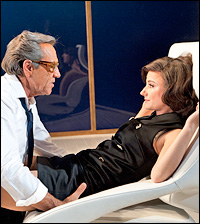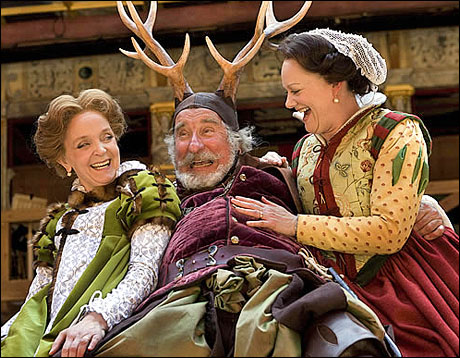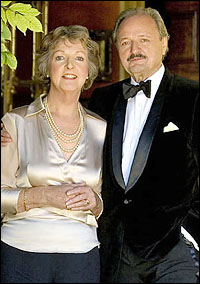*
 |
||
| Robert Lindsay and Lydia Leonard in Onassis |
||
| photo by Tristram Kenton |
Broadway seems almost as clogged as the West End. In addition to myriad American-grown offerings, a new clutch of shows from London is opening on Broadway this month: we've sent La Bête, The Pitmen Painters and Brief Encounter over there.
What we got in their place was the best of the summer's productions from all over Britain, coming home to roost in London for the autumn and beyond. Onassis, Martin Sherman's blockbuster play about the Greek millionaire's tangled romantic relationships with Maria Callas (Anna Francolini) and Jackie Kennedy (Lydia Leonard), comes into the Novello Theatre. The public abandonment of Callas by Onassis in pursuit of a bigger prize, the widow of the president of the United States, was one of the first celebrity scandals. Playing the title role, Robert Lindsay returns to the West End after too long in the lucrative fields of television drama and comedy. The temptation to play a character so well-connected and rich that he believes other people's rules don't apply to him was clearly irresistible. Onassis comes in from Chichester Festival Theatre in the bucolic Sussex countryside, where it was a summer hit. I'm betting it won't need the Pimm's on the lawn or a sunlit view of the gentle Sussex Downs to repeat its success in the cool of a West End fall.
*
 |
||
| Roger Allam as Falstaff in Henry IV, Part One |
||
| photo by John Haynes |
The Merry Wives of Windsor is really a sitcom, designed by clever old Shakespeare to amuse the queen without overtaxing her brain, which was, not surprisingly, much taken up with weightier matters of state. Our own Queen Elizabeth, unlike her namesake, is not known for her love of the theatre, although I once saw her smile at a production of Oklahoma!, which, she told me, is her favorite show. Of course, at the time of the first Elizabeth, America hadn't been invented yet, so she was deprived of musicals and had to make do with Shakespeare.
Now Shakespeare's own theatre is sending its much-acclaimed production to Los Angeles (Broad Stage, Santa Monica, CA) and New York (Pace University's Michael Schimmel Center for the Arts in Lower Manhattan, Oct. 28-Nov. 7) and then on an extensive British tour until Dec. 11. American Shakespeare addicts have been pouring into the Globe all summer to see the Henrys, starring Roger Allam as Falstaff, so they won't want to miss this one and only contemporary Shakespeare play, which sets him in a different and much funnier context.
 |
| Sarah Woodward, Christopher Benjamin and Serena Evans in The Merry Wives of Windsor |
| photo by John Tramper |
 |
||
| Penelope Keith and Peter Bowles |
||
| photo by BBC |
*
There's word that the paintings that are the subject of The Pitmen Painters, Lee Hall's beautiful National Theatre play currently running at Manhattan Theatre Club's Samuel J. Friedman Theatre on Broadway, are making their own trip across the ocean. While they make an appearance in the play and are indeed characters to match the group of miners who painted them, there is no substitute for seeing the paintings themselves. At the National Theatre, in the art gallery overlooking the busy lobby, they competed successfully with the constant hubbub, music performances, eating and drinking, and theatregoers on their way to one of the National's three theatres.
The paintings, made by the miners between 1934–1947, range from totally abstract to figurative, from ideas borne of imagination to images of the miners' everyday lives. They became famous, with exhibitions in London and throughout the world's art galleries, and they now have a permanent gallery especially built for them. The obscure miners who painted them in the northeast of England, far from London, showed what ordinary people could accomplish. Wouldn't New York like to see these fascinating works?
(Ruth Leon is a London and New York City arts writer and critic whose work has been seen in Playbill magazine and other publications.) *
Check out more of Playbill.com's international coverage, including London correspondent Mark Shenton's daily news reporting.










